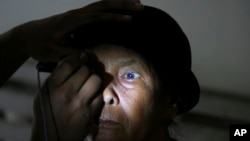Restoring sight by repairing tissues in the eyes can re-grow connections in the visual pathways of the brain, according to a new study. The authors said their work is evidence that the human brain is capable of forming new connections, even much later in life.
This novel discovery was the result of a two-step approach.
In a groundbreaking 2007 clinical trial, University of Pennsylvania opthamologist Dr. Jean Bennett used a cutting-edge gene therapy that targets the eye to restore sight in blind patients.
Two years after the procedure, her colleague, Manzar Ashtari, saw the unique opportunity to search for clues about how new visual experiences could reshape and stimulate unused brain connections. A widely-held belief about the brain is that there is a “critical window” or age range after which neural adaptations are not possible. Ashtari reported, this is “just not true.”
Restoring Sight with Gene Therapy
Ask any scientist who is working to restore sight to the blind and they will likely say the same thing: this is no easy feat.
Bennett was one of the first researchers to do it using gene therapy in animals, and then, for the first time, in humans. It targeted a gene that causes a rare genetic disease called Leber’s congenital amaurosis.
LCA was named after German physician Theodor Leber, known as “the father of experimental opthamology,” who, about a century ago, identified children born with very limited vision. “Congenital” refers to being born with the disease, and the Latin word “amaurosis,” literally means “no vision.” LCA patients gradually lose their sight completely.
According to Dr. Paul Sieving, director of the National Eye Institute, “The key to the treatment is that the problem [in LCA] originates from a single gene.”
The cause of blindness in LCA is now known to be the result of a bad copy of a single gene that helps break down Vitamin A, commonly found in carrots, into 11-cis retinal. Without 11-cis retinal, light does not get sent from the retina, a special light-sensitive tissue in the back of the eye, to the brain.
Bennet's work involves delivering a “good” copy of the non-functioning gene to the retinal cells of one eye in LCA patients.
“Since DNA does not cross cell membranes, it’s highly charged, you have to play tricks on it,” Bennet explained. “So what we did was package the DNA in essentially a shell of a virus to piggyback the normal copy of the genes into the diseased cells.”
The patients literally saw the benefits about a month after the procedure, as the genetic therapy repaired the retinal cells in their treated eye.
“Even the older subjects were reporting that they could see better,” Bennett said. “A woman who is 45 years old saw her daughter hit a home run, which is her dream come true.”
At the National Eye Institute, Sieving is testing gene therapy for other single-gene disorders that affect vision, of which, he said, there are several hundred.
Though this therapy may sound like a simple solution, he said, “This is really complicated, state-of-the-art biology. This is the frontier of research.”
Looking at the Newly-Sighted Brain
At this frontier, pioneers like Manzar Ashtari have found new ways to push the boundaries of what we know about the human brain.
“We know [the brain] is very plastic during development,” said Dr. Cheri Wiggs, a neuroscientist of vision at the National Eye Institute, who was not involved in the study. “Questions that people are trying to tackle now are 'how can you push that window and how plastic can the brain be over time?'”
Ashtari was able to answer this question because of what Wiggs said was a “principled and careful” decision to treat only one eye in the gene therapy study.
Doing MRI scans, two years after the study, allowed Ashtari to ask if the pathway between the patients' treated eye and their brain was better connected and more active than the pathway from the untreated eye.
She also compared the brain scans of the LCA patients to normally-sighted people, and reports she could see these differences clearly.
“The pathway that came from the treated eye looked very similar to the pathway of normal sighted individuals. The other pathway that was coming from the untreated eye was actually very frail, weak, and not looking normal.”
Ashtari said that shows the human brain is capable of creating new connections in a part of the brain that had been deteriorating from disuse.
After the study, the researchers delivered the gene therapy in the other eye. At first, the brain showed no response to the treatment. But, after letting the patient’s eye respond to light, Ashtari was amazed to see the neural response. It was, she said, "like the sun shining in their brain.”
Seeing this dramatic result in the older patient answers the question about how long this plasticity can extend in the lifespan.
Of these findings, published in Science Translational Medicine, Dr. Sieving said, “This is a very big breakthrough for both gene therapy and for understanding human vision.”











